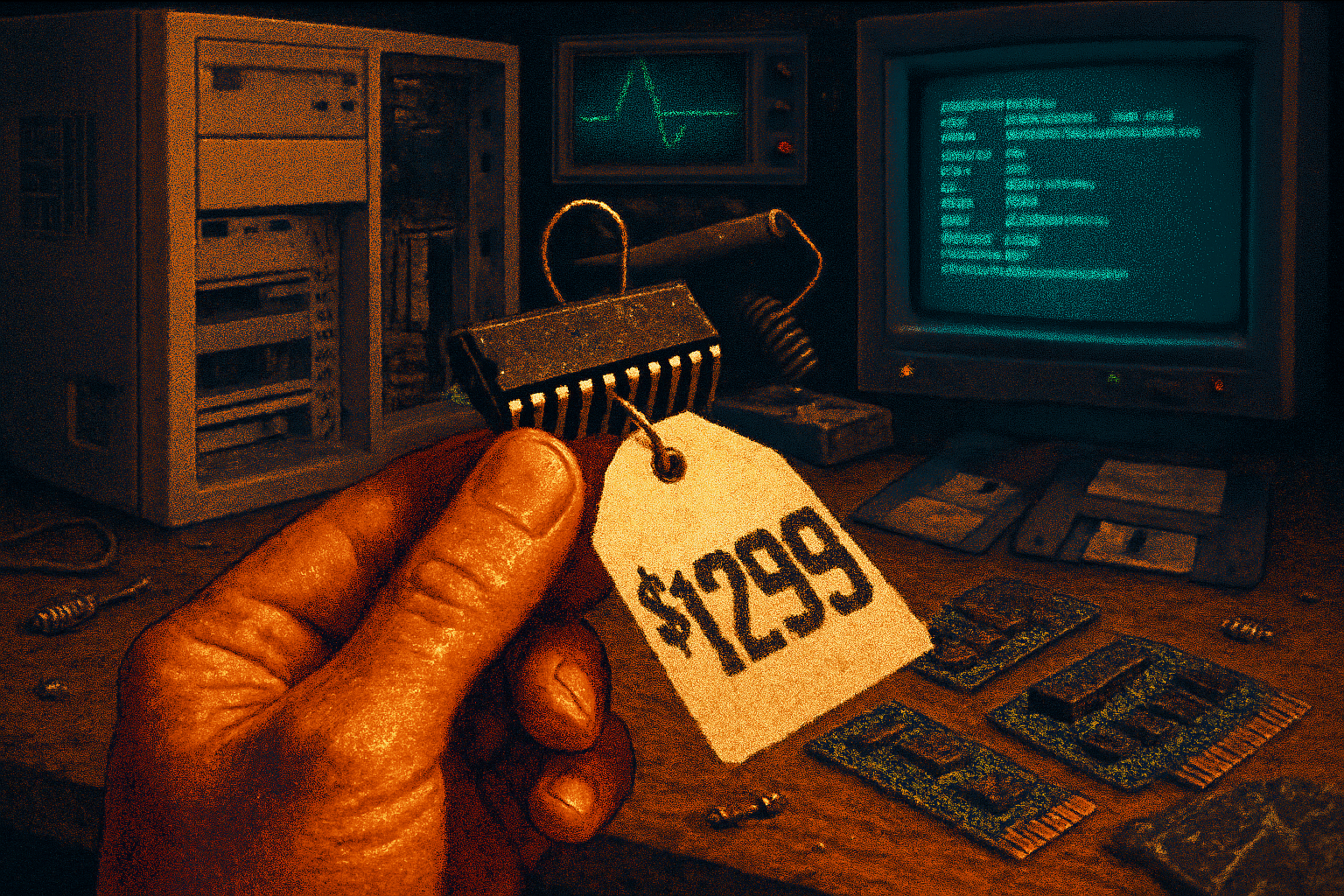· retrogaming · 7 min read
The Controversial 'Retro Gaming Tax': How Modern Trends Affect Classic Parts Prices
A deep look at why prices for vintage PC and console components have surged, who benefits and who loses, and whether this 'retro gaming tax' is stunting the retro PC community - plus practical steps communities and businesses can take to keep retro computing accessible.

Introduction
If you’ve tried to buy a working 486 motherboard, a spare ISA SCSI card, or an original game cartridge lately, you may have felt sticker shock. What hobbyists jokingly call the “retro gaming tax” - elevated prices for classic parts driven by modern demand - has become a real problem for many in the retro PC and gaming communities. This piece examines what’s driving the inflation, who it helps and hurts, and whether the trend is likely to stall the community’s growth.
Why prices are rising: demand and attention
Nostalgia and mainstream interest - Retro gaming is no longer a niche. Streaming video, YouTube restoration videos, speedruns, and social feeds have pushed vintage machines and games into mainstream awareness, increasing demand from both collectors and casual new entrants. You can measure this rising interest with public tools such as Google Trends ([search: “retro gaming”]).
Content creation and influencer culture - Restorations, “retro rig” showcases, and unboxings create aspirational images that raise demand for authentic parts and full working examples.
Collector markets and speculative buying - As with other collectible markets, some buyers purchase vintage hardware as an investment - removing items from circulation and driving scarcity.
Repair and preservation needs - Institutions, museums, and hobbyists need original parts to repair and preserve hardware. Many restoration projects require period-correct capacitors, plugs, or sockets that are no longer mass-produced.
Supply-side constraints that push prices up
Finite stock and part wear - Unlike mass-market electronics, many vintage components are unique, socketed, or one-off; once they’re used up, they’re hard to replace. Components age (electrolytic capacitors dry out, lubricant and plastics degrade), so working spares become rarer.
Obsolescence and discontinued supply chains - Manufacturers stopped producing many of these parts decades ago; the supply is largely what remains in basements, warehouses, or landfill recoveries.
Global supply disruptions - Broader semiconductor and logistics crunches - notably the recent global chip shortage - have shifted supply-chain attention and capacity away from legacy manufacturing, making small-run reproduction or new compatible components more expensive or slower to appear ([see: semiconductor shortage]).
Specialized knowledge and repair labor - Restoring old hardware isn’t plug-and-play. The scarcity of experienced technicians and the time-intensive nature of restoration raise service prices and, in turn, the effective cost of obtaining working hardware.
Where we have seen the effects (examples and patterns)
Consoles and cartridges - Classic cartridges and complete boxed consoles frequently fetch high prices because of nostalgia and collectibility (this is widely reported in collector communities and marketplaces).
Vintage PC boards and CPUs - Socketed CPUs, motherboards for 486/386-era machines, and ISA expansion cards have grown pricier as collectors and restoration enthusiasts compete for the same stock.
CRTs and monitors - Large CRTs and period-correct monitors have become scarce because many were discarded during the flat-panel transition; surviving units in good condition are highly sought after for authentic retro setups.
Is this stunting the retro PC community’s growth?
Short answer: Partly - in the short term. But it’s complicated.
Arguments that it is stunting growth
Raised barrier to entry - Higher prices deter newcomers who cannot afford authentic hardware, which narrows the community to those with disposable income or deep expertise.
Fewer working units to experiment with - Scarcity of inexpensive donor hardware limits opportunities for learning and tinkering, which are essential for community growth and skill transfer.
Fragmentation and gatekeeping - Inflated markets encourage hoarding and speculation, and can create a perception that retro computing is primarily for collectors, not learners.
Arguments that it isn’t (or won’t in the long term)
Innovation and alternatives - The same demand that pushes prices up also funds innovation. FPGA projects, repro PCBs, and modern drop-in replacements (socket adapters, recreation daughterboards) have proliferated. Projects like MiSTer and other FPGA efforts recreate hardware behavior without requiring the original chips ([MiSTer FPGA project]).
New micro-industries - Elevated prices can make it economically viable for small manufacturers or enthusiast-run shops to produce reproductions, re-cap kits, or aftermarket parts, expanding supply over time.
Community adaptability - Retro communities have a strong DIY culture: people share schematics, fabrication files (PCB designs), and repair guides. That collective effort can mitigate scarcity by enabling reproduction and repair.
Net effect
In the near term, inflated component prices do place a real cost barrier that can slow organic growth. But that same pressure is driving adaptive responses - reproduction hardware, software emulation, and community repair networks - which can restore accessibility if supported properly.
What the community and industry can do (practical steps)
For hobbyists and newcomers
Embrace alternatives - Use FPGA-based recreations and emulators for experimentation before investing in originals.
Start with beaters and learn to repair - Buying nonworking units for parts or training in basic electronics reduces cost and builds skills.
Share and barter - Local meetups, swap meets, and online swap groups reduce the need to buy at market prices.
For community organizations and influencers
Publish repair guides and part lists - Detailed documentation lowers the expertise barrier and economizes part use.
Run community parts banks - Pools of donor hardware or shared spare parts keep small projects affordable.
Prioritize preservation - Documenting software and hardware behavior reduces dependence on single points of failure in the future (use resources like the Internet Archive for software) ([Internet Archive]).
For small manufacturers and vendors
Offer reproduction runs and compatible replacements - Small-batch PCBs, reproduction cartridges, and capacitor kits can be profitable if the community supports them.
Transparent pricing and reasonable fees for restorations - Ethical seller behavior builds trust and long-term market stability.
For marketplaces
Support verified reproduction and parts categories - Distinguish genuine vintage items from reproductions and clearly list condition and provenance.
Consider tools to discourage bulk hoarding by speculators - Limits on purchases or flagged multiple-listing patterns can help keep supply in the hands of hobbyists.
Potential policy and ethical considerations
Intellectual property and repros - Some reproduction efforts risk IP issues; a balance should be found that prioritizes preservation and fair use over aggressive commercial enforcement.
Responsible collecting - Encouraging collectors to sell duplicates or fund community projects can circulate parts without attacking secondary markets.
A few promising trends to watch
FPGA and reproduction hardware - Projects that emulate hardware at the gate level are reducing dependence on original ICs and sometimes outperform the originals for convenience.
Small-scale manufacturing - The economics of small PCB runs and modern component sourcing make faithful reproductions increasingly practical.
Educational outreach - Workshops and community repair cafes create new hobbyists who know how to work with old parts rather than only buy them.
Conclusion: a glass half-full, with caveats
The “retro gaming tax” is real: modern demand, coupled with finite supply and speculative behavior, has raised prices and created higher short-term barriers for newcomers. That matters because hands-on access to hardware is how many people learn and enter the hobby.
But the story doesn’t end there. Pressure from high prices has already helped foster innovations (FPGAs, repros, community repair) that, if encouraged, will broaden access over time. If the retro computing community - including hobbyists, small businesses, marketplaces, and content creators - focuses on reproducible preservation, shared resources, and ethical marketplace behavior, the current tax can be transformed from a chokehold into an incentive for sustainable solutions.
Actionable takeaways
- Newcomers - start with emulation or FPGA recreations; learn on nonworking units; join swap communities.
- Community leaders - document repairs, run parts banks, and push for educational outreach.
- Vendors - consider small batch repros, transparent listings, and ethical sale practices.
If the community treats preservation and accessibility as core values - and turns the economic incentives toward reproduction and sharing - the retro hobby can grow even as original artifacts become rarer.
References
- Retrocomputing (overview): https://en.wikipedia.org/wiki/Retrocomputing
- Video game collecting: https://en.wikipedia.org/wiki/Video_game_collecting
- Global semiconductor shortage: https://en.wikipedia.org/wiki/Semiconductor_shortage
- Google Trends (search - “retro gaming”):
- MiSTer FPGA project: https://github.com/MiSTer-devel
- Internet Archive (software preservation): https://archive.org/
- r/retrobattlestations (community examples): https://www.reddit.com/r/retrobattlestations/


